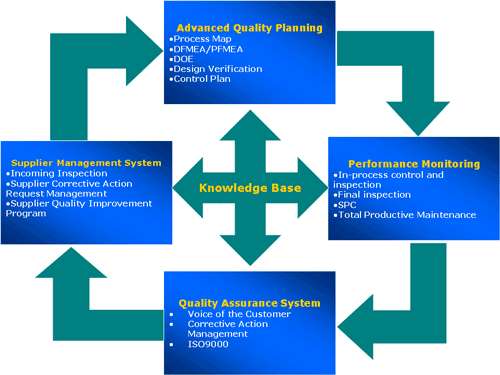|
In last month’s feature
article, we
discussed that a Six Sigma program must serve the corporate core
ideology – profitability; the major functions of a quality system are
monitoring performance and driving improvement; and we also concluded
that using a good software package to handle quality information will
significantly reduce the system implementation and maintenance cost. This
issue and the next several ones will be devoted to the topic of how to make
these theories work.
Recently I have learned
that although most of the quality professionals are experts at
the SPC software and Microsoft Excel, not
all of them are processing
the quality data in a systematic way by utilizing the concept of Quality
Information System. And most of the time, quality professionals tend
to
focus on reducing the cost of defectives, and neglect the hidden cost of
processing quality information – maintenance cost of a quality system.
So what is a Quality Information
System (QIS) and what are the differences between QIS and SPC
software? How does a poorly designed Quality Information System lead
the elevated quality cost and recoil the cost saving from the improvement
initiatives?
To answer these questions,
let me start with a basic introduction of an authentic QIS. Similar to
a Management Information System (MIS), a QIS contains processes
and subsystems that can store and process large amount of data and
provide intelligence information to help management control business
performance, and direct business operations.
Different from a MIS,
a QIS specializes on handling quality related data to drive continuous
improvements. A well-developed QIS can
-
collect and share quality information from manifold
sources within the organization
-
define key the problems and track the corrective actions
-
“learn” from the past failures and to prevent the
problem from reoccurring
-
support and push forward the organization-wide continuous
improvement
MRP/ERP type of software,
such as SAP, BPCS or Oracle, are part of an MIS, but they are not QIS.
As far as quality assurance concerned, in a MRP/ERP system, only the
results of a process will be collected, and many qualitative aspects of
the operational system and the process such as the root causes and
the description of non-conformance are not considered. A critical
drawback of this kind of software is that this kind of software is designed to only monitor the end results
of a process, but not to facilitate the problem solving and preventing. Since MRP/ERP
applications do not collect and store the information such as root causes
and corrective actions to build up the Quality Knowledge Base, they
are
not smart enough to “learn” and "suggest" to direct quality
improvements.
Similarly, the SPC software,
such as Minitab, is not a QIS either, since this type of software is
designed to accomplish project-based statistical calculations,
but not to establish a solid system to consolidate and analyze
the quality data from all aspects.
Contrary to MRP/ERP and SPC software,
a QIS is a
knowledge-based “smart” database. It will take advantage of the
information that collected from the process, both quantitative and
qualitative to help business identify the improvement opportunities,
find out the root causes, build effective corrective actions, and
proactively learn form the data and keep the potential problems from
occurring.
 The
graphic on the left illustrates example of such a QIS. This QIS contains five modules. The
graphic on the left illustrates example of such a QIS. This QIS contains five modules.
1) Supplier Management module,
consisting Incoming Inspection Management, Supplier Corrective
Action Management, and Supplier Quality Improvement Program functions.
2) Advanced Quality Planning
Module, storing data of Process Mapping, FMEA,
Design Verification, and Control Plan.
3) Performance Monitoring
Module, hosting operational data and generating
level 1,2,3 performance reports, and Total Productive Maintenance
status.
4) Quality Assurance module,
managing Voice of the
Customer, corrective actions, and ISO9000 procedures and activities.
5) Center of this QIS is
Quality/Process Knowledge Base, which will collect knowledge data
such as failure modes, corrective actions etc., results of corrective
actions to give user a chance to study the system behavior on higher
level. Besides, the Quality Knowledge Base will feed historical
summaries to other modules.
To help business implement a
pragmatic QIS, we at QIT Consulting have developed two programs to
facilitate the implementation of Supplier Management Module and
Performance Monitoring Module. Find out more details of these programs
and the services QIT consulting provides at
http://www.qitconsulting.com
In the next issue, we will contemplate on what kind
of information that need to be collected; what kinds of statistics
that need
to be calculated to make the system “smart enough” to direct
continuous improvement; and how to use QIS to enhance the results and
compensate for the shortcomings of the Six Sigma projects.
Copyright © 2003 QIT
Consulting, Inc.
|